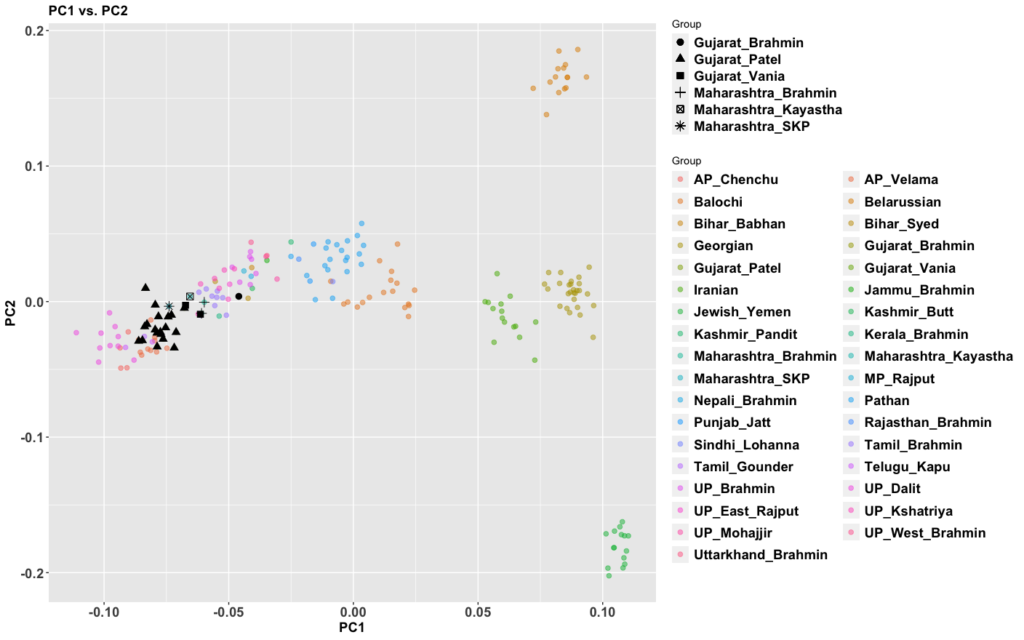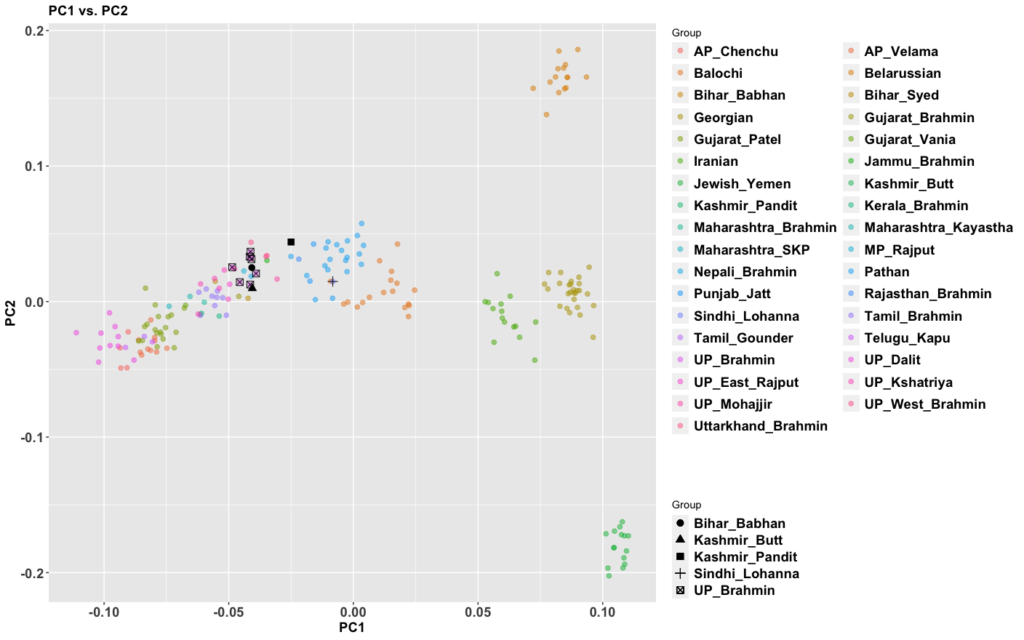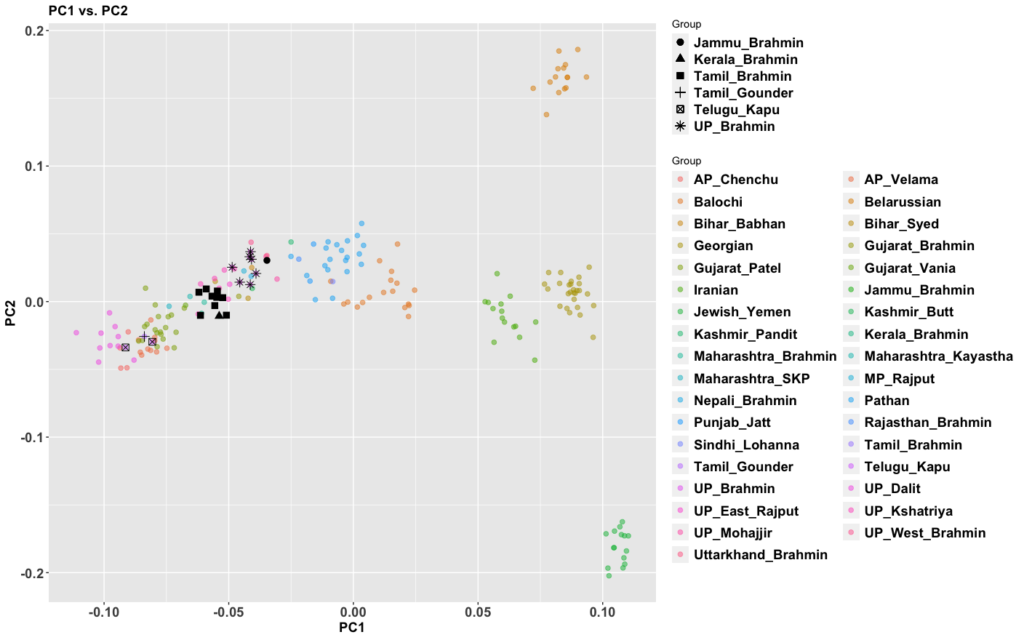Sometimes people pass me data. Turns out Rajasthani Brahmins are quite different from UP Brahmins (more northwest-shifted). In this, they are like Pandits. In contrast, Bihar Babhans are just like UP Brahmins, who don’t seem to have much structure. Gujarati Brahmins are between South Indian Brahmins and North Indian Brahmins, and closer to the latter, while Maharashtra Brahmins seem more like South Indian Brahmins.



In other words, Rajasthani Brahmins can be Castizo like most Kashmiri Pandits. There are some Gujarati Brahmins that are as west shifted as Rajasthan ones (also Castizo, like Mahesh Bhatt)
Gujarati Lohanas tend to be the most West shifted Gujarati Dharmic population on average (they are Castizo range) While Gujarati Parsis are the most West shifted population in all of Gujarat.
Rajasthani Jatts are the most West shifted population in Rajasthan. Though there are also populations of other smaller communities like Kamboj, Jaat etc and some of these are even more west shifted than Jatts, among the most west shifted populations in all South Asia.
it’s not informative to say ‘west shifted.’ lohannas and khatris are very west eurasian, but in an iranian-farmer direction. jatts and pathans are more steppe shifted…
Do you see a lot of structure within Gujarati Brahmin groups? Looking at the Illustrative DNA South Asian PCA’s, the Gujarati Brahmin cluster seems to form a cline. For what it’s worth, I am from the Nagar community and cluster with Kashmiris and Punjabis (about 30% steppe-related ancestry).
(Interesting tangent – my wife is from the V3 Luhar community in Gujarat, but seems to have more steppe-related ancestry than many Brahmins – roughly 25%. Does anyone know if this community has a history of migrating from Northwest India?
She also has a bit of BMAC (1.8%) and Southeast Asian (1.4%). Is this noise? Reflective of Munda ancestry? Is she a Kushan? Hepthalite? What’s going on here?)
Noise. Lot of groups get those small shifts on illustrative, especially BMAC for pretty much all high steppe groups.
Unsure of reason for cline. Wiki says Lohars are artisinal caste people who claim to be Brahmins. They might be Brahmin origin with non brahmin current jobs. Something like gangetic Bhumiars. But that’s a quick guess.
Even Banias are bit different.
Gangetic Banias are like Reddys and Patels. Gujarati and some Rajasthani ones have a slight North shift and are like S Indian Brahmins.
Maharashtra has a few different brahmin castes.
Some (deshshtha – largest brahmin caste) are stereotypically darker than others (chitpavan – second largest brahmin caste).
Do genetics reflect this ?
No. Chitpavans are very similar to S Indian Brahmins. There was election for lighter pigment skin and eye color. This is similar to many Kashmiri groups vs. some Jatts (parallel to chitpavans to S Indian Brahmins).
Sumit know this next part. But for others. Phenotype genes are tiny part of whole genome. So they can get biased relatively easily due to selection; however, genotype as a whole may not change much.
Some very phenotypically similar groups like Andaman Islanders and some Sub-Saharan African groups can be genotypically quite far apart. So opposite works too. Basically phenotype isn’t always a good proxy.
there is evidence for natural selection in chitpavans in the genetic data, so yeah.
rahul ligma btw is a deshastha who is not kala. he asked me about it
So I am a Southie Brahmin (Chitpavan) 🙂 who doesn’t speak a non-IE tongue. I am not particularly fair nor do i have any typical Chitpavan features.
I mean, even you know it’s a frequency thing. There’s a ton of overlap between groups. But the interwebz tends to obessess over the non insignificant minority and even sometimes super minority variants of groups, especially if they look West shifted.
Anecdotally, I get asked if I am from all over. I am very pan indic looking. Just regular medium brown guy.
What’s the average percentage of AASI, Iranian_N and Steppe for Southern/Maharashtra Brahmins?
I cluster very close to that typeish (more Andhara and Iyers but those tend to be close enough). I’m a tiny bit more IVC shifted. But it’s like a 60 20 20 is maybe split of IVC AASI Steppe on G25 with illustrative DNA and a chunk of the IVC (like 30% is AASI).
For steppe, N Indians Brahmins about 25-30%. Similar for Pak Jutts and Gujjars who are more IVC than their eastern counter parts are. Haryana Jaats and Rors are up to 35-40% steppe.
Most IVC groups are like Todas, Gujjars, and some St. Thomas Christians, iirc. But groups like Patels, Reddy, and Kama are also more IVC enriched. The difference is that the Pak heavy IVC groups have more steppe and the Indian ones more AASI (only Pak one I listed above is Pak Gujjars but Pak Lohanas and Khatris of course are others).
Most AASI type are Irula. Dalits, controlling for region have the most. But the cline is both caste and geographic. Punjabi Chamars, Gujarati Banias, and Iyer Brahmins can all cluster close together, for example. But their historiography is quite different.
A question for @Razib. Have you done any work on Memons? I ask since someone mentioned Lohanas. If so what’re they like?
Thanks.
Memons seem like Lohana converts.
At least going by Pravaras and religious practices, I have noticed most Tamil Brahmins, and proximate Brahmin groups, are usually from a few clans and all followers of the Taittiriya-Apastambha school.
Anyone know about the similar practices of Desastha and Chitpavan groups?
Greetings! Razib.
Apologies, if this query is misplaced / sounds naive. Curious since I saw some references to Gujarati and Iyer Brahmins in this thread.
So to give you a quick context – I’m a Southern Indian with ancestral origins in Karnataka (Kodagu), did run a test using all the calculators of GEDMATCH and the most frequent population result has been either GujaratiB (for some reason there are four classifications for Gujaratis A-B) or Tamil Nadu Brahmin. I don’t have any ancestors from these ethnicities. Wondering if you have developed any new calculators that have samples representing ethnicities from Kodagu or there abouts? Any thoughts, pls?
hey razib, nepali brahmins were actually khas people we are not brahmins